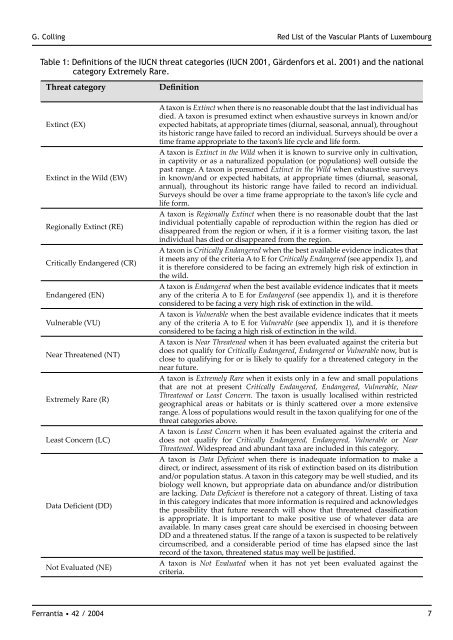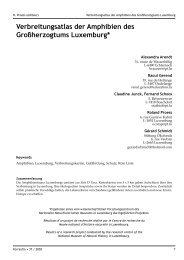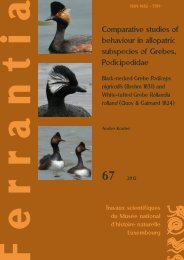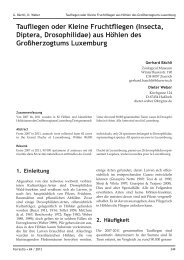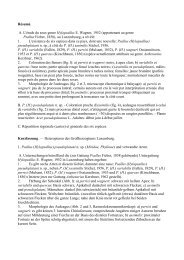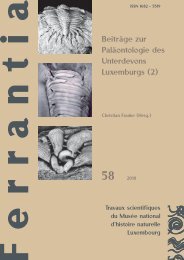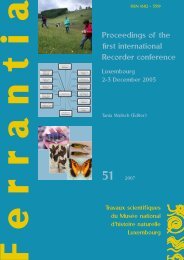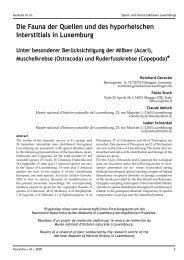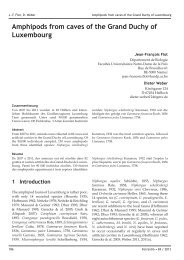Ferrantia 42 - Musée national d'histoire naturelle
Ferrantia 42 - Musée national d'histoire naturelle
Ferrantia 42 - Musée national d'histoire naturelle
Create successful ePaper yourself
Turn your PDF publications into a flip-book with our unique Google optimized e-Paper software.
G. Colling Red List of the Vascular Plants of Luxembourg<br />
Table 1: Definitions of the IUCN threat categories (IUCN 2001, Gärdenfors et al. 2001) and the <strong>national</strong><br />
category Extremely Rare.<br />
Threat category Definition<br />
Extinct (EX)<br />
Extinct in the Wild (EW)<br />
Regionally Extinct (RE)<br />
Critically Endangered (CR)<br />
Endangered (EN)<br />
Vulnerable (VU)<br />
Near Threatened (NT)<br />
Extremely Rare (R)<br />
Least Concern (LC)<br />
Data Deficient (DD)<br />
Not Evaluated (NE)<br />
<strong>Ferrantia</strong> • <strong>42</strong> / 2004<br />
A taxon is Extinct when there is no reasonable doubt that the last individual has<br />
died. A taxon is presumed extinct when exhaustive surveys in known and/or<br />
expected habitats, at appropriate times (diurnal, seasonal, annual), throughout<br />
its historic range have failed to record an individual. Surveys should be over a<br />
time frame appropriate to the taxon’s life cycle and life form.<br />
A taxon is Extinct in the Wild when it is known to survive only in cultivation,<br />
in captivity or as a naturalized population (or populations) well outside the<br />
past range. A taxon is presumed Extinct in the Wild when exhaustive surveys<br />
in known/and or expected habitats, at appropriate times (diurnal, seasonal,<br />
annual), throughout its historic range have failed to record an individual.<br />
Surveys should be over a time frame appropriate to the taxon’s life cycle and<br />
life form.<br />
A taxon is Regionally Extinct when there is no reasonable doubt that the last<br />
individual potentially capable of reproduction within the region has died or<br />
disappeared from the region or when, if it is a former visiting taxon, the last<br />
individual has died or disappeared from the region.<br />
A taxon is Critically Endangered when the best available evidence indicates that<br />
it meets any of the criteria A to E for Critically Endangered (see appendix 1), and<br />
it is therefore considered to be facing an extremely high risk of extinction in<br />
the wild.<br />
A taxon is Endangered when the best available evidence indicates that it meets<br />
any of the criteria A to E for Endangered (see appendix 1), and it is therefore<br />
considered to be facing a very high risk of extinction in the wild.<br />
A taxon is Vulnerable when the best available evidence indicates that it meets<br />
any of the criteria A to E for Vulnerable (see appendix 1), and it is therefore<br />
considered to be facing a high risk of extinction in the wild.<br />
A taxon is Near Threatened when it has been evaluated against the criteria but<br />
does not qualify for Critically Endangered, Endangered or Vulnerable now, but is<br />
close to qualifying for or is likely to qualify for a threatened category in the<br />
near future.<br />
A taxon is Extremely Rare when it exists only in a few and small populations<br />
that are not at present Critically Endangered, Endangered, Vulnerable, Near<br />
Threatened or Least Concern. The taxon is usually localised within restricted<br />
geographical areas or habitats or is thinly scattered over a more extensive<br />
range. A loss of populations would result in the taxon qualifying for one of the<br />
threat categories above.<br />
A taxon is Least Concern when it has been evaluated against the criteria and<br />
does not qualify for Critically Endangered, Endangered, Vulnerable or Near<br />
Threatened. Widespread and abundant taxa are included in this category.<br />
A taxon is Data Deficient when there is inadequate information to make a<br />
direct, or indirect, assessment of its risk of extinction based on its distribution<br />
and/or population status. A taxon in this category may be well studied, and its<br />
biology well known, but appropriate data on abundance and/or distribution<br />
are lacking. Data Deficient is therefore not a category of threat. Listing of taxa<br />
in this category indicates that more information is required and acknowledges<br />
the possibility that future research will show that threatened classification<br />
is appropriate. It is important to make positive use of whatever data are<br />
available. In many cases great care should be exercised in choosing between<br />
DD and a threatened status. If the range of a taxon is suspected to be relatively<br />
circumscribed, and a considerable period of time has elapsed since the last<br />
record of the taxon, threatened status may well be justified.<br />
A taxon is Not Evaluated when it has not yet been evaluated against the<br />
criteria.<br />
7


